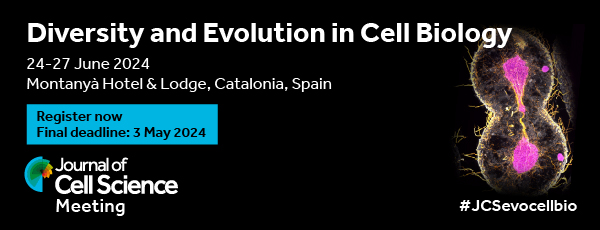Issues
-
Cover image
Cover Image

Cover: Unilateral cleavage furrows in a multi-nucleate Dictyostelium cell. In this cell, actin is labelled red and microtubules are labelled green. See article by G. Gerisch et al. (jcs259648).
- PDF Icon PDF LinkTable of contents
- PDF Icon PDF LinkIssue info
RESEARCH HIGHLIGHTS
EDITORIAL
FIRST PERSON
CELL SCIENTISTS TO WATCH
ESSAYS
REVIEWS
Deep learning – promises for 3D nuclear imaging: a guide for biologists
Summary: Deep-learning methods are introduced for users, highlighting accessible methods for 3D nucleus analysis and encouraging interdisciplinary research between computer scientists and biologists.
Dopey proteins are essential but overlooked regulators of membrane trafficking
Summary: Dopey proteins regulate membrane trafficking and play crucial roles from morphogenesis to neural function, but remain poorly understood. This Review discusses these fascinating enigmas.
RESEARCH ARTICLES
Patterning of the cell cortex and the localization of cleavage furrows in multi-nucleate cells
Summary: Multi-nucleate Dictyostelium cells divide by unilateral cleavage furrows that progress and expand according to a pattern of cortexillin and myosin II that is determined by microtubule asters at the spindle poles.
Platelet-derived microvesicles regulate vascular smooth muscle cell energy metabolism via PRKAA after intimal injury
Summary: VSMCs are stimulated by platelet microvesicles via PRKAA after vascular injury, and Compound C treatment is a potential therapy for neointimal hyperplasia.
Recruitment of Peroxin 14 to lipid droplets affects lipid storage in Drosophila
Summary: Targeted RNAi or overexpression of Peroxin genes in Drosophila fat body or cells revealed peroxisome independent roles in lipid storage, with Pex14 causing the strongest phenotypes.
Phosphorylated paxillin and phosphorylated FAK constitute subregions within focal adhesions
Summary: Phosphorylated paxillin and phosphorylated FAK form patterns in focal adhesions, creating local signaling hubs in a regulated manner.
Vertebrate lonesome kinase modulates the hepatocyte secretome to prevent perivascular liver fibrosis and inflammation
Summary: The secreted protein kinase VLK is released from hepatocytes and protects the liver from perivascular fibrosis and inflammation.
Tandem C2 domains mediate dynamic organelle targeting of a DOCK family guanine nucleotide exchange factor
Summary: DOCK family GEFs are master regulators of cellular organization. We discovered that tandem C2 domains in the superfamily members enable GEF clustering at specialized sites of full activation.
The histone variant macroH2A1.1 regulates RNA polymerase II-paused genes within defined chromatin interaction landscapes
Summary: Histone variant macroH2A1.1 binding to the TSS of genes dependent on Pol II pausing stimulates transcription by promoting Pol II release in a human triple-negative breast cancer cell model.
Visualising the cytoskeletal machinery in neuronal growth cones using cryo-electron tomography
Highlighted Article: Cryo-electron tomographic reconstruction of neuronal growth cone subdomains reveals distinctive F-actin and microtubule cytoskeleton architectures and modulation at molecular detail.
Upregulated flotillins and sphingosine kinase 2 derail AXL vesicular traffic to promote epithelial-mesenchymal transition
Summary: Deregulation of vesicular trafficking by upregulated flotillins involves sphingosine kinase 2, and contributes to high AXL levels and to epithelial-to-mesenchymal transition in breast cancer cells.
Oligopeptide transporter Slc15A modulates macropinocytosis in Dictyostelium by maintaining intracellular nutrient status
Highlighted Article: The oligopeptide transporter Slc15A is a novel macropinocytosis regulator in Dictyostelium and part of a positive feedback mechanism, coupling nutrient status and macropinocytosis.
Piezo1 activation attenuates thrombin-induced blebbing in breast cancer cells
Highlighted Article: Thrombin and protease-activated receptor agonists induce dynamic blebbing in breast cancer cells, which can be attenuated by contact-mediated compression, and activation of the mechanosensitive ion channel Piezo1.
SIRT1 regulates cardiomyocyte alignment during maturation
Summary: Analyses of mouse embryos and cardiomyocytes differentiated from human embryonic stem cells show that SIRT1 regulates cardiomyocyte alignment during development, in part through chemotaxis.
Introducing our new Editors

We welcome three new Editors to Journal of Cell Science - Robert Parton, Richa Rikhy and Simon Cook. You can read more about them in the Editorial from our Editor-in-Chief Michael Way.
2024 Journal Meeting 'Diversity and Evolution in Cell Biology'

Registration is open for our 2024 Journal Meeting Diversity and Evolution in Cell Biology, which aims to bring together evolutionary biologists and cell biologists investigating diverse aspects of cellular physiology. Final registration deadline: 3 May 2024.
Workshop: Physics of the Early Embryonic Cell Divisions

Early-career researchers interested in the roles of nuclear lipids, apply now for one of the ten funded places at this Workshop, which will take place 11-14 November 2024. Application deadline: 17 May.
Reasons to submit to Journal of Cell Science

There are many benefits to publishing in Journal of Cell Science - read more about why you should choose JCS or visit our submission page now.
Propose a new Workshop for 2026

We are now accepting proposals for our 2026 Workshops programme. We aim to be responsive to the community and open to novel initiatives, so if you have a new idea for a biological workshop that you feel would work well, please apply. Applications deadline: 19 July 2024.



